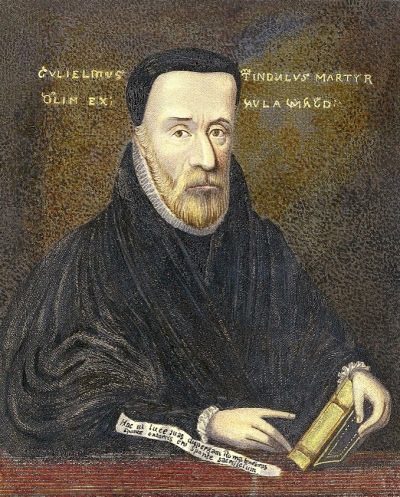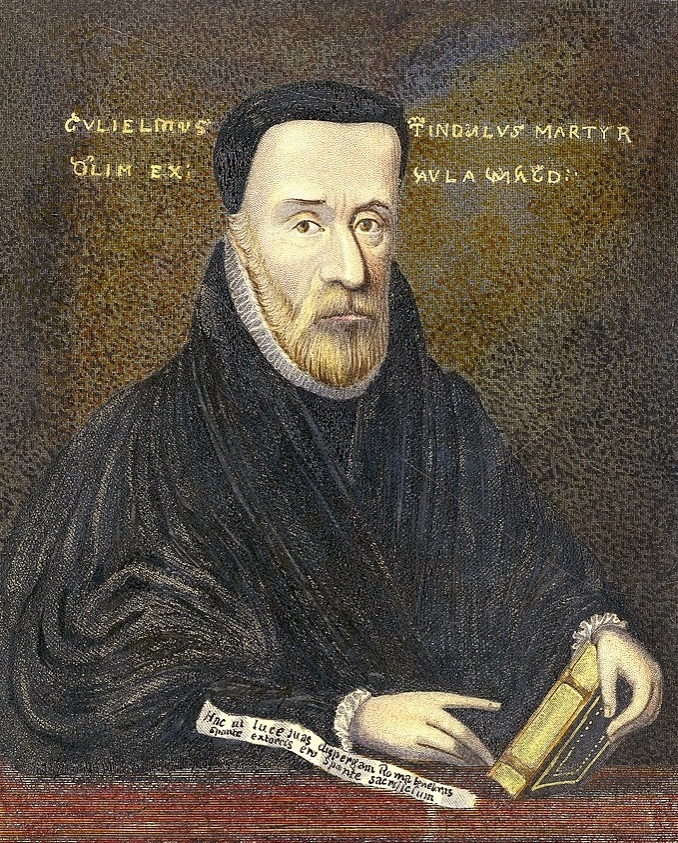
Oct. 6 is the day when Anglicans around the world, and Lutherans in North America, remember William Tyndale. This year is also the 500th anniversary of his first publication. This is the story …
Upbringing
William Tyndale was born in south Gloucestershire in western England, near Bristol, in the early 1490s. The year and the place are not certain, but it was likely in or near the village of Stinchcombe near Dursley. He was born into the fairly wealthy Tyndale (also spelled Tindall) family, who also went by the surname of Hychyns (also spelled Hitchens). He was educated and seems to have been brought up in Lollard circles, who were early Evangelicals who used English. Tyndale was sent to Oxford, where he learned Latin and graduated in 1512, having become proficient in a number of languages. He trained as a priest and was ordained in London in 1515. It is likely that he spent some time in Boston, Lincolnshire, and at Cambridge.
The state of the Bible
The official Church Bible then was the Latin Vulgate translated by St. Jerome. It was a good translation for the time, but the main problem was that most people did not know Latin. The only English translation then was the Wycliffe Bible, used by the Lollards, who were considered heretics. The Wycliffe Bible had two main problems, which were that the language was very Latinate and not very natural, and, in any case, by the 1500s, English had changed a lot and it was quite archaic. Tyndale would have known the story of how John Trevisa from nearby Berkeley had translated the Gospels for Queen Anne, wife of Richard II.
Developments in Europe
During this time, some significant developments in mainland Europe had led to the Reformation. In 1516, the Dutch priest and humanist Erasmus brought out his first edition "Novum Instrumentum omne," which included the first published Greek New Testament and a revised Latin translation, which highlighted flaws in Jerome’s text. Erasmus released a second edition in 1519, with many typographical errors corrected, and a third edition in 1522 with some textual changes.
Martin Luther used this, and in 1522 Tyndale would have heard that Martin Luther had published a New Testament in vernacular German translated from the Greek. It might have been then that Tyndale, determined to translate the Bible into everyday English from the original Greek, or maybe the idea was set before when he was with the Lollards. Either way, with Erasmus’ Greek, the Latin and Luther’s German, Tyndale now had the reference materials for his life’s mission.
The translator
From about 1522 to 1524, Tyndale was employed as a chaplain by Sir John Walsh at their home of Little Sodbury Manor. It is generally believed that it was here in the safety of this house, which is still standing, that William Tyndale did much of his translation of the New Testament. At that time, there was a rule about Bible translation into English. It was not technically illegal, but it nearly was, because the Constitutions of Oxford, dating from 1407, stipulated that Bible translation into English had to be done with the authorization of a bishop.
William Tyndale, perhaps naively, thought that the Bishop of London would be pleased to grant him permission, so he returned to London, where he took lodgings with Humphrey Monmouth. The Bishop of London, Cuthbert Tunstall, did not give permission, and now with his plans known, he feared for his safety and fled to mainland Europe.
Tyndale in mainland Europe
In 1524, Tyndale went to what is now Germany, which at the time was a cluster of states in the Holy Roman Empire. He is believed to have gone to Wittenberg, where Luther was based. By 1525, Tyndale had a manuscript of a complete English New Testament, replete with notes and cross-references, and he was in Cologne (Köln) to supervise its printing with Peter Quentell in secrecy. It was a dangerous pursuit because Cologne was Catholic. It is believed that careless talk in the print room gave the game away. The printer sent Tyndale a messenger to tell him his work was about to be impounded.
Cologne fragment
Tyndale and his assistant, William Roye, escaped with that section which had been printed so far amounting to the first quarto. The few pages that had been printed were rescued. Tyndale escaped with the first octavo, which includes his prologue, contents and the first 22 chapters of the Gospel According to St Matthew, known as the "Cologne fragment" and stops at Matthew 22:12.
His prologue starts, “I Haue here translated (brethern and susters moost dere and tenderly beloued in Christ) the newe Testament for youre spirituall edyfyinge, consolacion, and solas.”
The Cologne Fragment was smuggled into England and Scotland and arrived 500 years ago in 1525. It was the first printed part of the Bible in English to come into people’s hands. That Christmas, 500 years ago in 1525, was the first Christmas when people could read the Christmas story from Matthew in plain English for themselves. It was only 22 chapters, but it gave people a taste of what was to come. The only known surviving copy can be found in the Grenville Collection of the British Library in London.
Antwerp
Tyndale went to Antwerp where he found another printer. He was able to get the New Testament printed in 1526. This is the first-ever complete New Testament in English to be published. Meanwhile, Tyndale wrote polemic literature, which made his theology known.
His views were similar, although not identical to Luther’s, but also owed much to his Lollard upbringing. He essentially believed in justification by faith, that people should be able to use their own language and not Latin, that priests should not be forced to be celibate, that the bread and wine of communion was symbolic, and that the Bible took precedence over the traditional teachings of the Church.
Betrayal and execution
Tyndale went on to publish some Old Testament books, but he was betrayed in Antwerp and handed over to the authorities for trial in 1535. He was tried for heresy, which, according to the authorities, was clear from his publications. He was condemned and burned at the stake. He was not technically executed for translating the Bible into English, which was not illegal in the province of Brabant, where he was, but that was the reason the English authorities wanted rid of him.
He was imprisoned in Vilvoorde Prison and executed. The traditional date is Oct. 6, which is why that is the day to remember Tyndale in the Anglican calendar, but the actual date might have been the end of September or a few days earlier in October. At the stake, he is traditionally believed to have said, “Open the king of England’s eyes.”
Legacy
Tyndale’s legacy is that his translation work was the basis of later Bible translation into English. If you read the New Revised Standard Version or the English Standard Version, it is essentially a modernized and updated version of Tyndale in the New Testament.
Tyndale coined a number of theological terms which we still use today, such as atonement, Passover and scapegoat, and his work had a profound influence on the development of the English language. For more information about William Tyndale, see the Tyndale Society website https://www.tyndale.org/
Collect
The Anglican collect prayer for Oct. 6 is: “Lord, give to your people grace to hear and keep your word that, after the example of your servant William Tyndale, we may not only profess your gospel but also be ready to suffer and die for it, to the honor of your name; through Jesus Christ your Son our Lord, who is alive and reigns with you, in the unity of the Holy Spirit, one God, now and for ever.”
News Source : https://www.christianpost.com/news/william-tyndale-on-500th-anniversary-of-his-first-printed-work.html
 Your post is being uploaded. Please don't close or refresh the page.
Your post is being uploaded. Please don't close or refresh the page.





